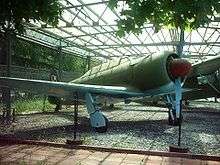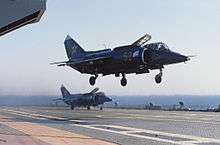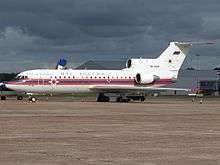Yakovlev
.png) | |
| Division | |
| Industry | |
| Founded | Moscow, Russia (January 15, 1934) |
| Founder | Alexander Sergeyevich Yakovlev |
| Products | Military aircraft |
| Parent | Irkut |
| Website |
www |
The JSC A.S. Yakovlev Design Bureau[1][2] (Russian: ОАО Опытно-конструкторское бюро им. А.С. Яковлева) is a Russian aircraft designer and manufacturer (design office prefix Yak). Its head office is in Aeroport District, Northern Administrative Okrug, Moscow.[3]
Overview
The bureau was formed in 1934 under designer Alexander Sergeyevich Yakovlev as OKB-115 (the design bureau has its own production base at the facility №115), but the birthday is considered on 12 May 1927, the day of maiden flight of the AIR-1 aircraft developed within the Department of Light Aircraft of GUAP (Head Agency of Aviation Industry) under the supervision of A.S. Yakovlev.
During World War II Yakovlev designed and produced a famed line of fighter aircraft.
Yakovlev was acquired by Irkut in April 2004.[4] The Russian government merged the holding company with Mikoyan, Ilyushin, Irkut, Sukhoi and Tupolev as a new company named United Aircraft Building Corporation in February 2006.[5]
The firm is the designer of the Pchela (Russian: Пчела, "bee") drone reconnaissance aircraft and is perhaps best known for its highly successful line of World War II-era piston-engined fighter aircraft.
The name Yakovlev is used commonly in the West, but in Russia it is always abbreviated as Yak (Russian: Як) as a part of an aircraft name. The German transliteration, often used by the Russians, Poles, and others as well, is Jak.
Aircraft


Early aircraft
- AVF-10 (1924 - glider)
- AVF-20 (1925 - glider)
- AIR-1/VVA-3/Ya-1 (1927 - biplane trainer)
- AIR-2/Ya-2 (1928 - biplane trainer, improved AIR-1)
- AIR-3/Ya-3 (1929 - high speed monoplane trainer developed from the AIR-2)
- AIR-4/Ya-4 (1930 - improved AIR-3)
- AIR-5 (1931 - airliner)
- AIR-6/Ya-6 (1932 - airliner/air ambulance)
- AIR-7/Ya-7 (1932 - high speed trainer/record-setting)
- AIR-8 (1934 - liaison version of AIR-3)
- AIR-9 (1935 - trainer/record-setting)
- AIR-10/Ya-10 (1935 - precursor of UT-2)
- AIR-11 (1936 - general purpose, 3-seat version of AIR-10)
- AIR-12 (1936 - long-range racing aircraft)
- AIR-14 (1936 - prototype of UT-1)
- AIR-15/UT-15 (1938 - racing aircraft)
- AIR-16 (1936 - 4-seat version of AIR-10)
- AIR-17/Ya-17/UT-3 (1937 - 3-seat crew trainer)
- AIR-18 (1937 - re-engined UT-1)
- AIR-19/Ya-19 (1939 - civil version of UT-3)
- Ya-20 (1937 - prototype of UT-2)
- Ya-21/UT-21 (1938 - re-engined UT-1)
- Ya-22/I-29 (1939 - multi role combat aircraft prototype)
Fighters
- Yak-1 (1940 - World War II fighter)
 Yakovlev Yak-38 fighter aircraft of the Novorossiisk heavy aircraft carrying cruiser of the Pacific Fleet.
Yakovlev Yak-38 fighter aircraft of the Novorossiisk heavy aircraft carrying cruiser of the Pacific Fleet. - Yak-3 (1943 - World War II fighter)
- Yak-7 "Mark" (1941 - World War II single-seat fighter)
- Yak-9 "Frank" (1942 - World War II fighter/bomber, improved Yak-7DI)
- Yak-15 "Feather" (1946 - first successful Soviet jet fighter, developed from Yak-3U)
- Yak-17 "Feather" (1947 - jet fighter, development of Yak-15)
- Yak-23 "Flora" (1948 - fighter, development of Yak-15/Yak-17)
- Yak-38 "Forger" (1975 - V/STOL shipborne fighter)
Bombers
- Yak-2 (1940 - World War II bomber)
- Yak-4/BB-22 (1941 - World War II bomber, improved Yak-2)
- Yak-28 "Brewer" (1958 - multi-role bomber)
- Yak-28P "Firebar" (1961 - long-range interceptor version of the Yak-28)
Airliners, transport and utility aircraft
- Yak-6/NBB (1943 - military transport/night bomber)
- Yak-10 "Crow" (1945 - liaison, commuter transport)
- Yak-12 "Creek" (1946 - liaison, general purpose utility aircraft)
- Yak-14 "Mare" (1948 - military transport glider)
- Yak-18T (1967 - 4 seat aerobatic trainer)
- Yak-40 "Codling" (1966 - commercial passenger)
- Yak-42 "Clobber" (1977 - commercial passenger, developed from Yak-40)
- Yak-58 (1993 - light utility)
- Yak-112 (1993 - general purpose)
Reconnaissance
- Yak-25 "Flashlight" (1954 - interceptor)
- Yak-27 "Flashlight" and "Mangrove" (1958 - fighter/reconnaissance)
- Yakovlev Pchela (1990s - unmanned reconnaissance aircraft)
- Yakovlev Yak Voron "Raven" ( - unmanned long-range aircraft)
- Yakovlev Yak Albatro-Expert ( - unmanned reconnaissance aircraft)
Helicopters
- Yak-24 "Horse" (1952 - transport helicopter)
- Yak-100/Yak-22 (1948 - transport helicopter design)
Trainers
- UT-1 (1936 - single-seat trainer)
- UT-2 "Mink" (1937 - 2-seater trainer)
- UT-3 (1937 - 3-seater trainer)
- Yak-7 "Mark" (1941 - World War II 2-seat trainer)
- Yak-11 "Moose" (1946 - trainer, developed from Yak-3)
- Yak-17V/Yak-17UTI "Magnet" (1948 - trainer version of Yak-17)
- Yak-18 "Max" (1946 - tandem two-seat military primary trainer)
- Yak-18T (1967 - 4- or 5-seat civilian primary trainer)
- Yak-20 (1950 - trainer)
- Yak-21 (1947 - trainer)
- Yak-28U "Maestro" (1962 - trainer version of the Yak-28)
- Yak-30 "Magnum" (1960 - trainer prototype, designation reused)
- Yak-32 "Mantis" (1960 - trainer, single-seat version of Yak-30)
- Yak-50 (1975 - aerobatic aircraft)
- Yak-52 (1974 - aerobatic and military trainer)
- Yak-53 (1975 - aerobatic trainer, single-seat version of Yak-52)
- Yak-54 (1994 - aerobatic trainer developed from the Yak-55M)
- Yak-55 (1981 - aerobatic)
- Yak-130 "Mitten" (1992 - trainer)
- Yak-152 (2016 - trainer)
- Yak-200 (1953 - multi-engined trainer)
- Yak-210 (1953 - multi-engined navigator trainer developed from the Yak-200)
Experimental
- Yak-3/I-26U/I-30 (1941 - World War II fighter prototype)
- Yak-5/I-28 (1940 - World War II fighter prototype)
- Yak-EG (1947 - experimental helicopter)
- Yak-8 "Crib" (1944 - transport, improved Yak-6)
- Yak-13 (1945 - improved Yak-10, prototype only)
- Yak-16 "Cork" (1948 - civilian transport)
- Yak-19 (1947 - prototype jet fighter)
- Yak-25 (1947 - fighter prototype, designation reused)
- Yak-26 "Flashlight" (1955 - tactical bomber, developed from Yak-25)
- Yak-30 (1948 - fighter prototype, development of Yak-25)
- Yak-33 (early 1960s - V/STOL fighter, bomber, reconnaissance aircraft project)
- Yak-36 "Freehand" (1963 - VTOL demonstration aircraft)
- Yak-41 "Freestyle" (1975 - early name for Yak-141 VTOL fighter)
- Yak-43 (1983 - projected replacement for VTOL Yak-141 fighter)
- Yak-141 "Freestyle" (1989 - prototype supersonic VTOL fighter)
.jpg) Yak-141 VTOL fighter during hover at 1992 Farnborough Airshow
Yak-141 VTOL fighter during hover at 1992 Farnborough Airshow - Yak-44 (1980s - carrier-capable airborne early warning)
- Yak-45 (1973 - failed air superiority fighter design)
- Yak-46 (1990s - failed push prop design developed from the Yak-42)
- Yak-50 (1949 - fighter prototype, development of Yak-30, designation reused)
- Yak-60 (late 1960s - tandem-rotor heavy-lift helicopter design)
- Yak-140 (1954 - light-weight experimental fighter)
- Yak-140 (1955 - experimental fighter aircraft)
- Yak-1000 (1951 - high-speed experimental aircraft)
- VVP-6 (experimental VTOL transport and weapons platform)
Planned aircraft
- Irkut MC-21 (proposed short- and medium-range airliner)
- Yak-48 (1998 - proposed commercial passenger)
- Yak-77 (1993 - proposed twin-engine business, regional commuter airliner)
International aircraft projects
See also
- Saratov Aviation Plant
- Smolensk Aviation Plant
- List of military aircraft of the Soviet Union and the CIS
- SOKOL Aircraft Building Plant
References
- ↑ A.S.Yakovlev Design Bureau - General Data
- ↑ UAC - General information
- ↑ Home page. Yakovlev. Retrieved on 30 August 2011. "125315 Russia, Moscow, Leningradskiy prospect, 68" Address in Russian: "125315 Россия, Москва, Ленинградский проспект, 68"
- ↑ Irkut Corporation Completes Yakovlev Design Bureau Acquisition. defense-aerospace.com, April 22, 2004.
- ↑ "Russian Aircraft Industry Seeks Revival Through Merger." The New York Times. February 22, 2006.
- A book by A.T.Stepanets. Yak Fighters in WWII [ISBN 5-217-01192-0] (in Russian)
- Степанец А.Т.- Истребители "Як" периода Великой Отечественной войны. Справочник. - М.: Машиностроение, 1992. - 224 с.: ил:
External links
| Wikimedia Commons has media related to Yakovlev. |
- http://www.yak.ru click on ENG for English.
- http://www.yak-54.com/ Yakovlev Aircraft of USA.
